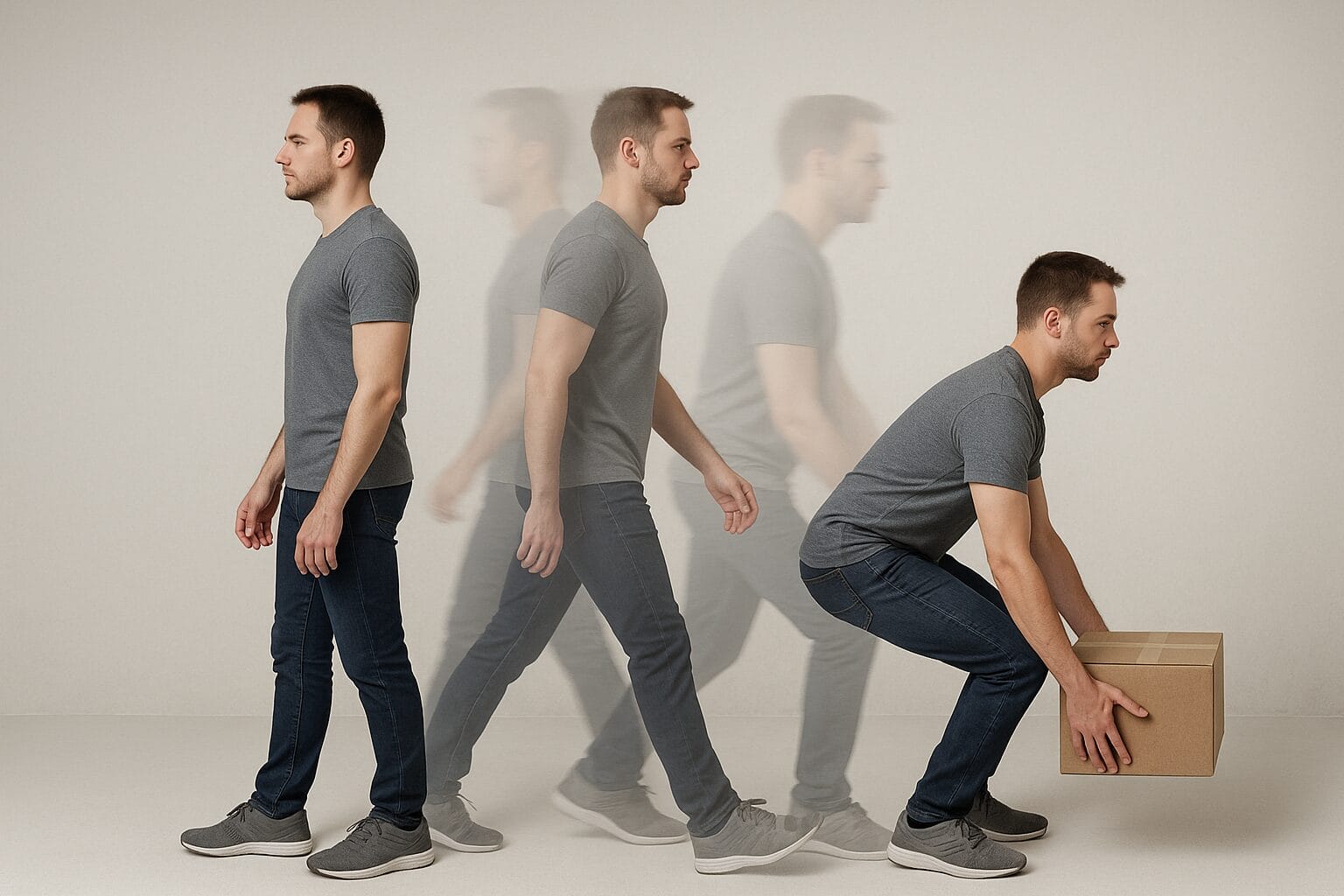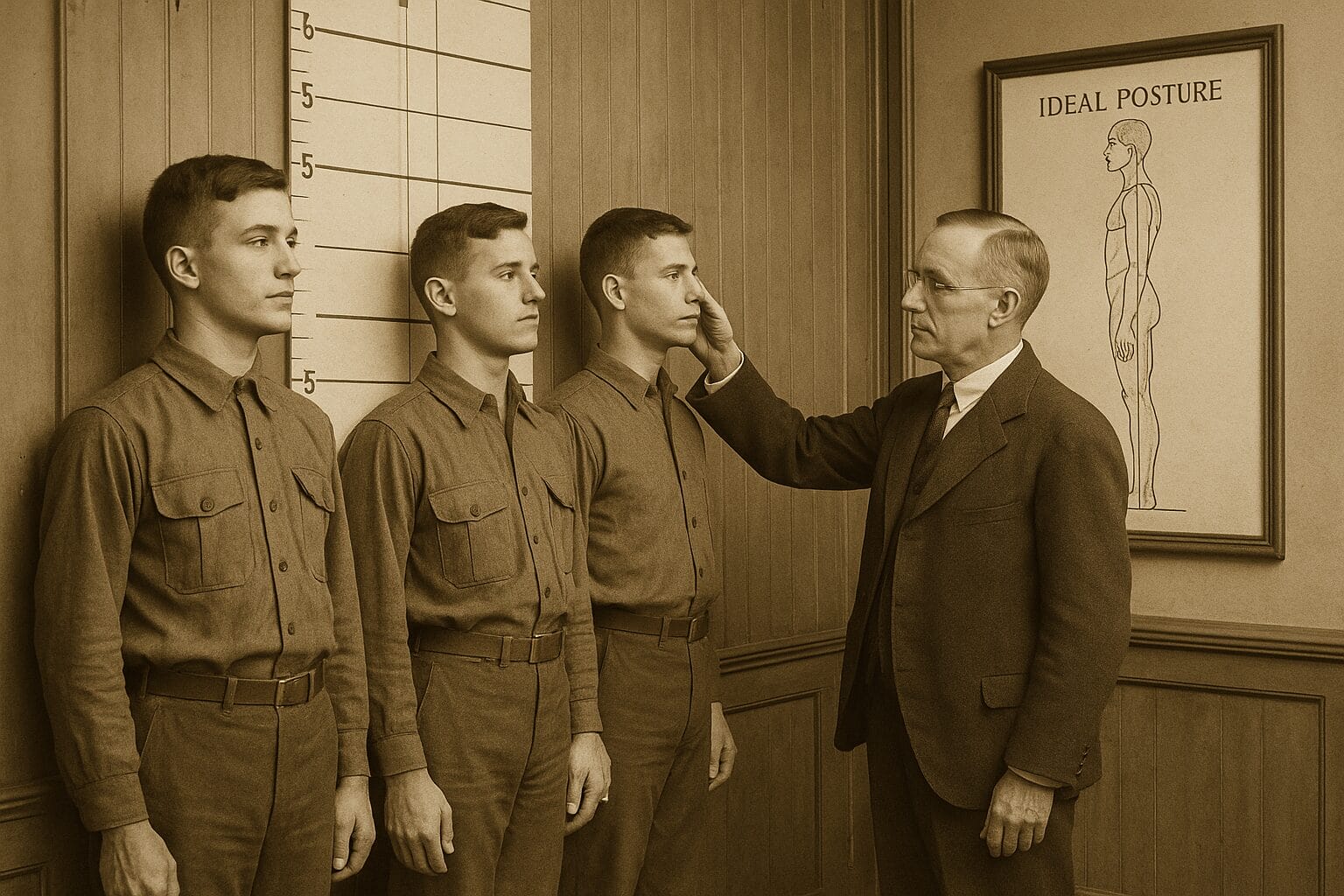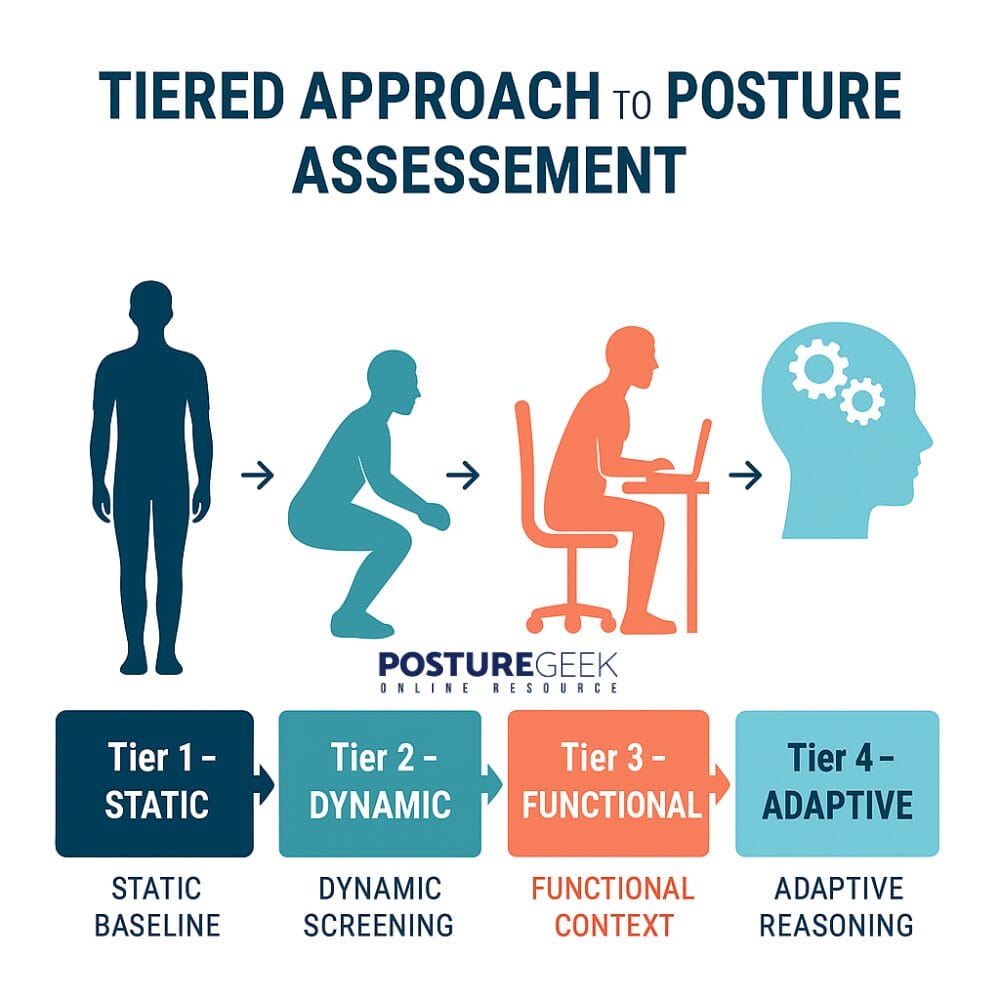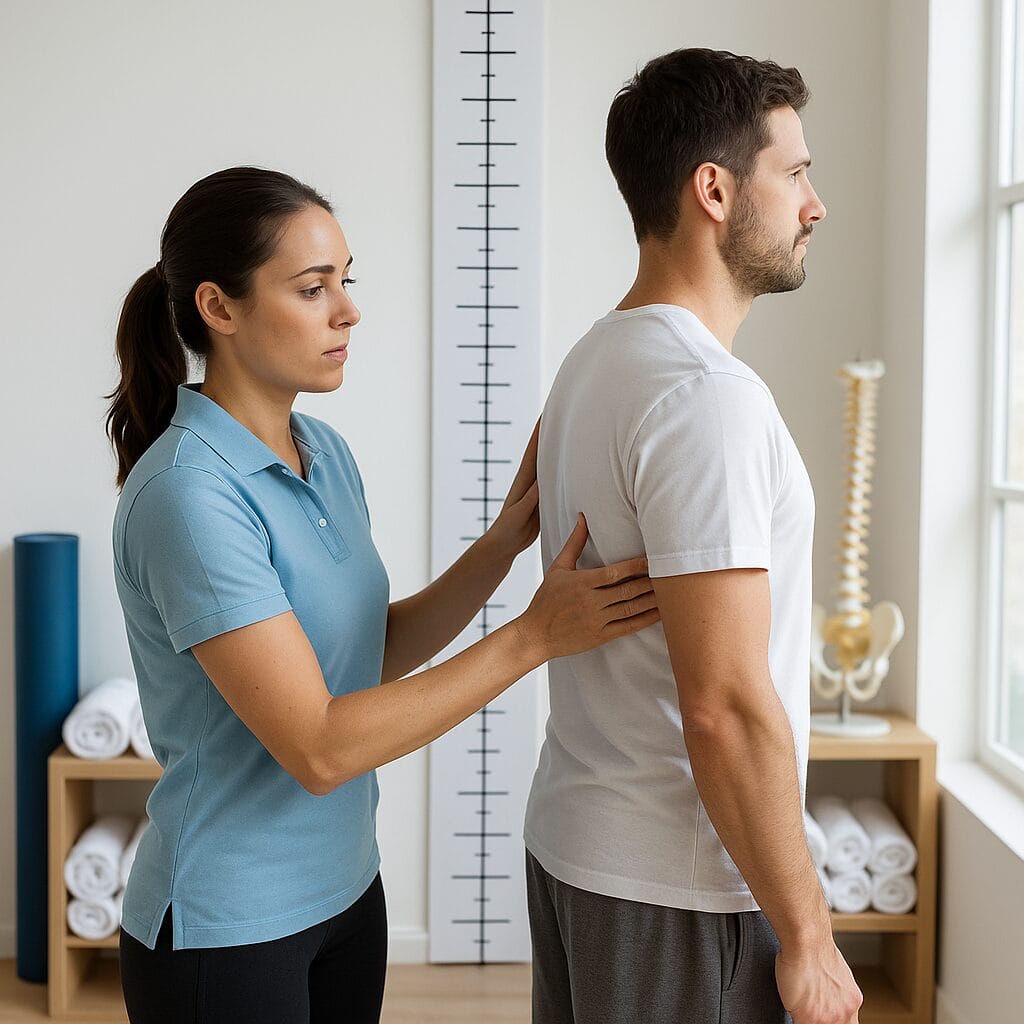Beyond Standing Straight: How Posture Assessment Really Works in the Real World
- Updated - August 29, 2025

Most people still think of posture assessment as standing in front of a plumb line (static posture assessment) while someone checks if your shoulders, hips, or knees line up. For decades, this static model has been treated as the gold standard.
But here is the problem: humans are not statues. We do not live life in frozen positions. We move, adapt, compensate, and reorganize moment by moment. Looking only at static posture is like judging an athlete by their team photo. It leaves out everything that actually matters.
That does not mean static assessment is useless. It still has value, however, if we want posture assessment to truly reflect how people live and function, it needs to evolve.
The Origins of Static Posture Assessment

The idea of measuring posture against an “ideal” dates back to the early 20th century. Schools, gyms, and military programs lined people up and compared them against rigid standards. A straight back, squared shoulders, and level hips were all treated as signs of health, discipline, and strength.
Clinically, this approach made sense at the time. Without modern imaging or movement science, static alignment was easy to observe, record, and teach. But what was once a useful reference became dogma.
Today, we know that posture is far more than a fixed alignment. It is the body’s ongoing negotiation with gravity, load, emotion, and environment. Static assessment reveals only the initial frame of a much larger movie.
The Limitations of Static Posture
Static alignment tests are quick and straightforward. They can reveal asymmetries, biases, or strain patterns. But on their own, they do not predict performance, pain, or resilience.
- Someone can look “aligned” standing still, but collapse into poor mechanics as soon as they squat or run.
- Another person can look crooked but function with surprising efficiency because their body has adapted intelligently.
- A third can appear symmetrical at rest, yet in motion, one side does all the work while the other side coasts.
If we stop at static assessment, we risk missing the real story.
This is especially important because people rarely come to a practitioner complaining that their “plumb line looks off.” They go because they cannot run without pain, cannot sit without fatigue, or cannot perform at their best. Static posture may give a clue, but it does not explain the whole picture.
Discover a practitioner near you.
Looking for a practitioner near you? Our extensive network of qualified professionals is here to help you.
Where Static Posture Still Helps
Static assessment is not irrelevant. Used correctly, it offers real clinical value:
- Quick Baseline: A fast “before and after” reference when testing the effect of treatment.
- Low-Demand Entry Point: Useful when a client cannot tolerate complex movement tests.
- Visual Feedback: Clients often appreciate seeing immediate change when they stand taller or look more balanced after a session.
- Personal Comparisons: More meaningful when comparing someone to themselves over time than against a textbook ideal.
In this way, static posture is best viewed as a checkpoint tool, rather than the final word. It is the beginning of inquiry, not the conclusion.
A Tiered Approach to Posture Assessment

To truly understand posture, we need to expand from static snapshots into a layered, dynamic model.
Tier 1: Static Baseline (Snapshot)
- Purpose: A starting point and quick reference.
- Clinical Example: After a hip flexor release, the pelvis shifts from anterior tilt toward level. The change is visible in standing even before deeper testing begins.
- Everyday Example: A client notices that after treatment, they appear taller in the mirror, which boosts confidence and builds buy-in.
Tier 2: Dynamic Screening (Movement Checks)
- Purpose: Reveal compensations that standing still hides.
- Clinical Example: A client who stands balanced may show knee valgus when squatting, revealing hidden hip instability.
- Everyday Example: A runner who looks upright at rest begins to twist their torso excessively once fatigue sets in.
Tier 3: Functional Context (Real-World Tasks)
- Purpose: Connect posture to meaningful activity.
- Clinical Example: The office worker sits tall at the start of a session, but collapses forward within minutes when working at their desk. This shows endurance and load tolerance issues, not simply alignment.
- Everyday Example: A parent who looks aligned at rest may struggle to lift their child from the floor without compensating through the back.
Tier 4: Adaptive Reasoning (Integration Loop)
- Purpose: Tie everything back to why posture looks the way it does.
- Questions to ask:
- What is this posture accomplishing?
- What is it compensating for?
- Does a change in static posture translate to function?
- Clinical Example: A client’s forward head posture improves after thoracic mobilization. But if they still revert during prolonged sitting, the reasoning must shift toward endurance training and task-specific strategies.
Clinician Takeaway
Applying the Four Tiers in Practice
- Static Baseline
- Use as a starting snapshot or quick before-and-after reference.
- Do not over-interpret alignment against an “ideal.”
- Ask: Did my intervention make any visible difference right now?
- Dynamic Screening
- Add transitional movements, such as squats, lunges, or overhead reaches, to your routine.
- Look for when and where control breaks down.
- Ask: Does this person move differently than they stand?
- Functional Context
- Bring in client-specific tasks, such as desk work, running stride, or lifting.
- Observe endurance, fatigue, and efficiency as well as alignment.
- Ask: How does posture show up in real-world activity?
- Adaptive Reasoning
- Synthesize findings across all tiers to identify drivers, not just symptoms.
- Compare change over time against the person’s own baseline.
- Ask: What is this posture accomplishing, and how can I expand options for adaptation?
Why This Matters
When posture assessment evolves beyond static alignment, it becomes:
- More accurate because it accounts for how people actually move and adapt.
- More useful because findings directly inform treatment strategies.
- More empowering because clients view posture as a dynamic, adaptive process, rather than a judgment of right versus wrong.
For practitioners, this layered approach establishes a feedback loop that enables continuous improvement. Each tier informs the next, and together they guide interventions in a way that static posture alone never could.
Posture as Adaptation, Not Perfection
One of the most critical shifts in thinking is moving away from the idea of “ideal posture” as a fixed target. No two bodies are the same, and no single alignment works for everyone.
Posture is best understood as an adaptation:
- A way the body distributes load when joints are stiff or muscles are weak.
- A strategy for efficiency when energy is limited.
- A reflection of both history (injuries, habits, conditioning) and current demand.
Seen this way, posture assessment becomes less about grading someone against an external standard and more about understanding the strategies their body is using. The goal is not to impose an ideal, but to expand options so the body can adapt in healthier, more efficient ways.
A Real-World Example

Consider two clients with forward head posture.
- Client A works in IT and spends ten hours a day at a desk. Their forward head is not just a neck issue. It is a whole-system adaptation to years of sitting, breathing shallowly, and using vision at a screen distance.
- Client B is a weightlifter whose forward head posture is most noticeable when bracing under a heavy load. In this case, the pattern is linked to thoracic stiffness and breathing strategies under pressure.
Both present with the same static posture. However, once movement and context are layered in, the reasoning and, therefore, the treatment plan become entirely different.
fOR THE CLIENT
What This Means for You
- Standing still is only the beginning
- How you look when you stand tells part of the story, but not the whole story.
- Movement reveals more
- The way you squat, reach, or walk often shows things that standing still cannot.
- Everyday life matters
- Posture is shaped by what you do most often, whether that is sitting at a desk, lifting children, or training in the gym.
- Posture is about adaptation, not perfection
- There is no single “right” way to stand. The goal is to help your body adapt in ways that feel stronger, easier, and more balanced.
The Takeaway

Posture is not a fixed picture. It is a process, a way the body manages forces, choices, and change over time. Static assessment still has a role, but only as the opening note in a much bigger story.
By layering static, dynamic, functional, and adaptive assessments, we stop chasing an outdated “ideal posture” and start engaging with posture as it really is: living, adaptable, and meaningful.
Closing Note
At PostureGeek, posture is not about forcing people into rigid positions. It is about understanding how bodies adapt and helping them adapt more effectively. For practitioners, that means moving beyond static checklists into dynamic reasoning. For the public, it means realizing posture is not about perfection but about resilience and freedom in movement.
Frequently Asked Questions
1. Is posture assessment only about standing straight?
No. Standing still can provide a quick baseline, but a comprehensive posture assessment should also include movement, everyday tasks, and how the body adapts under various conditions. Looking only at static posture misses the bigger picture of how people function.
2. Why is static posture assessment still useful?
Static assessment is helpful as a simple checkpoint. It can show immediate changes after treatment, act as a low-demand entry point, and provide clients with visible feedback. It is most valuable when comparing someone to themselves over time, not against a textbook ideal.
3. What is the difference between static Posture and dynamic posture assessment?
Static posture assessment looks at alignment while standing still. Dynamic posture assessment examines how the body moves during tasks such as walking, squatting, or reaching. Dynamic assessment often reveals compensations and weaknesses that static alignment alone cannot show.
4. Can poor posture cause pain?
Posture itself is not “good” or “bad.” Pain usually develops when the body has fewer options to adapt. By broadening movement strategies and improving endurance, posture becomes more efficient and resilient, which often reduces strain and discomfort.
5. How can I improve my posture in daily life?
Improving posture is less about holding a perfect position and more about building variety, strength, and awareness. Regular movement breaks, task-specific adjustments, and simple exercises can help the body adapt better to the demands of daily life.
Resources
Articles:
The relationship between static and dynamic postural deformities with pain and quality of life in non-athletic women.
- Authors: Maria Batebi, Behnaz Ganji Namin, Mohammad Hossein Nasermelli, Maryam Abolhasani & Amir Hesam Salmasi Fard
- Summary: This 2024 study found that both static and dynamic posture measurements can predict injury. Importantly, they offer different insights into postural control, reinforcing the idea that static alignment alone is incomplete.
- Read the article here
Are static and dynamic postural balance assessments two sides of the same coin? A cross-sectional study in older adults”
- Authors: Alex Rizzato, Antonio Paoli, Marta Andretta, Francesca Vidorin & Giuseppe Marcolin
- Summary: In this 2021 study, researchers found no significant correlation between static balance and dynamic postural control. Under dual-task conditions, dynamic balance was more severely disrupted.
- Read the article here
PLEASE NOTE
PostureGeek.com does not provide medical advice. This information is for educational purposes only and is not intended to be a substitute for professional medical attention. The information provided should not replace the advice and expertise of an accredited health care provider. Any inquiry into your care and any potential impact on your health and wellbeing should be directed to your health care provider. All information is for educational purposes only and is not intended to be a substitute for professional medical care or treatment.
About the author
Join our conversation online and stay updated with our latest articles.
Find Expert Posture Practitioner Near You
Discover our Posture Focused Practitioner Directory, tailored to connect you with local experts committed to Improving Balance, Reducing Pain, and Enhancing Mobility.
